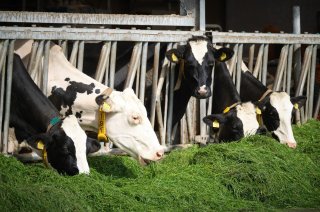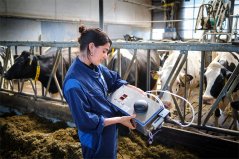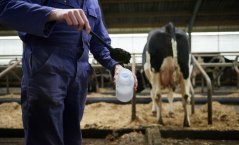
Longread
Climate and livestock: practical innovations for reduced greenhouse gas emissions
Climate disasters are increasingly affecting the world. One of the main contributors is the greenhouse gas effect, and livestock farming contributes to this. This must and can be done differently. Together with farmers, governments and industry, Wageningen University & Research is working on practical solutions to reduce greenhouse gas emissions from livestock farming.
‘Humanity is pumping abnormally large volumes of greenhouse gases into the air,’ says researcher Marion de Vries. ‘As a result, the earth is warming up, causing shifts in precipitation patterns and temperature’.
Methane
Around ten per cent of the Netherlands' greenhouse gas emissions comes from livestock farming. A lot of methane (CH4) in particular is released into the air, but also nitrous oxide and carbon dioxide. Livestock farming is the largest contributor of methane in the Netherlands.
Methane is created when feed is digested in the gastrointestinal tract of animals and from manure. De Vries: ‘The sector can make a big difference in reducing greenhouse gas emissions. Research of Wageningen Livestock Research in the fields of nutrition, genetics and manure focuses on the effectiveness of measures, making solutions practical and on passing on knowledge for sustainable livestock farming. We do this in conjunction with other sustainability assignments, such as water quality, animal welfare and biodiversity.’
- Unfortunately, your cookie settings do not allow videos to be displayed. - check your settings
Tinkering with rations
Animals' menu has a lot of influence on the amount of methane an animal produces. ‘Ruminants such as cows and goats can break down tough grass fibers with the help of bacteria in the rumen. That digestion releases methane: they breathe or burp it out,’ says researcher André Bannink. ‘We can tinker with the diet to reduce emissions.’
As an example, Bannink cites forage quality. ‘Our research shows that replacing grass silage with maize with a high starch content reduces methane emissions; starch is easy to digest. In a ration with a quarter of maize as roughage, it reduces methane with three to four per cent compared to a ration with only grass silage as roughage.’
Replacing part of the grass silage with maize reduces methane emissions

Fresh grass
Fresh grass, straight from the pasture, also appears to reduce methane emissions. Having only fresh grass on a cow's menu in spring results in methane reductions of up to thirty per cent compared to ensiled grass.
Researchers compared methane emissions from cows grazing in pastures or receiving fresh grass in the barn with a ration of only grass silage in the barn. ‘We measured methane emissions from the cow's mouth and nose via sensors in modified concentrate feeding boxes,’ says researcher Cindy Klootwijk. ‘We saw that the reduction is greatest for day and night grazing and in spring. Young, fresh grass is easily digestible and has a different composition from grass silage.’
We saw that the reduction is greatest for day and night grazing and in spring
Additives
Another promising option is adding methane-reducing additives to the ration. Bannink: ‘Our research shows that some feed additives strongly reduce methane emissions from dairy cows, and this also depends on the ration and how much methane inhibitor is added.’' An already applied additive gives no health effects: the synthetic substance 3-NOP breaks down quickly in the rumen and is converted into natural substances.
Research is also being done on herbs as additives which reduces methane by influencing the microflora in the rumen. ‘Attention is needed here for micro-organisms adapting quickly to these herbs, which may somewhat limit their potential to reduce methane,’ according to Bannink.
- View this showcase: Changing the cow’s diet reduces methane and nitrogen emissions
Methane emissions from pig farming
Greenhouse gas emissions from pig farming are lower than from dairy farming. Yet, this sector also needs to contribute to reduce methane emissions. Researcher Alfons Jansman is working on a targeted approach to influence methane formation in the animal's large intestine and methane formation from manure via nutrition. ‘One of the methods we are investigating is adapting pig feeds to influence both the supply of fermentable carbohydrates, from which methane can be formed, and the microbiome in the pig's digestive tract and in the manure.’
To measure methane from manure, the researchers mix feces and urine from pigs, as occurs in the manure pit. ‘We observe that methane emission is increasing when manure is in the manure pit for a longer period of time. If we assume feeding more circular diets in the future and feed more by-products, such as sugar beet pulp, methane emissions will be higher. This might have a negative impact on methane emission when occurring uncontrolled. You can, however, ferment pig manure in a fermenter and store the methane formed in the process in a controlled way. This gas can be used as biofuel.’
Breeding for lower CH4
In the search for the low-emission cow, eyes are not only on feed. Researchers also see opportunities for breeding. They found that there are substantial differences between individual cows in methane emissions and that about twenty per cent of these are heritable.
Breeding for methane emissions could yield a reduction of around one per cent per year, rising to a maximum of a quarter by 2050. From this research, breeding values for methane have been developed and will be published, such that farmers can use the information in their bull choice.
Data from 15 thousand cows
This requires a lot of data. ‘We collected data from about 15 thousand cows via sniffers on a hundred farms,’ explains researcher Anouk van Breukelen. ‘We measure breath in the milking robot, to collect individual methane emission information from each cow. We link the data to the animals' pedigree and DNA information. Using this, we estimate breeding values from which we can deduce how much methane offspring of bulls will emit on average. Breeding for methane is possible without consequences for production and health, for example, by weighing the traits in selection indices.’
We collected data from about 15 thousand cows via sniffers on a hundred farms

According to Aniek Bouwman, methane emission reduction through breeding can be accelerated if data on the rumen microbiome is included. A Scottish study shows that breeding on both methane emissions measured in breath and the microbiome can increase methane reduction.
‘The genetics of dairy cattle partly determine the composition of the rumen microbiome. From nearly a thousand cows whose methane emission data and genotypes we know; we determined the microbiome in rumen fluid. Using this data, we discovered which specific microorganisms are heritable and have an effect on methane emission,’ Bouwman explains. Currently, rumen microbiome data cannot be measured on a large scale, therefore scientists are investigating alternatives such as the microbiome from buccal swaps to see if the methane related microorganisms are represented in the cheek mucus.
Influencing rumen microbiome
Researchers are following cows at different ages that have been inoculated with specific micro-organisms from the rumen fluid of dairy cows with high or low methane emission in the first three weeks of life. Indeed, it appears possible to use the composition of the rumen microbiome to influence the level of methane emission from cows.
‘Until cows are one year old, we indeed see lower methane emission in cows inoculated with micro-organisms from low-emitting cows,’ says researcher Sanne van Gastelen. ‘The composition of the microbiome in the rumen can clearly be influenced. We see this during measurements of methane from breath. The cows do not differ in growth and feed intake. We will investigate what the results are when cows are older.’
Methane from manure
Methane is not only released from the animal's digestive tract. Twenty per cent of cows' methane emissions comes from manure. ‘Dairy barns in the Netherlands are traditionally equipped with slatted floors above a deep manure pit where the slurry is stored for long periods of time,’ says researcher Hendrik Jan van Dooren. ‘The manure contains digestible organic matter and micro-organisms break it down. This produces methane if no oxygen is available during decomposition. It is possible to reduce methane production by frequent oxygen supply. Methane emission from manure decreases by about 20 to 40 per cent if you briefly mix manure with air bubbles several times a day.’
Methane emission from manure decreases by about 20 to 40 per cent if you briefly mix manure with air bubbles several times a day
Van Dooren also sees other possibilities, such as oxidising the methane produced from external manure storages. ‘Methane is then captured and converted into water and carbon dioxide. This can be done by burning (flaring) air or using bacteria. Research into a biofilter in which this is done has yet to show whether that method works well. The biogas is captured from a manure storage and blown into a biofilter. There, bacteria convert the methane into the less harmful carbon dioxide.’
This carbon dioxide from manure is different from carbon dioxide from fossil fuels, and does not contribute to the greenhouse effect. It is part of the so-called short carbon cycle, where carbon dioxide from the air is sequestered in grass, then eaten by the cow and then released back into the air as carbon dioxide via manure.

Reduce ammonia at the same time
In the Practical Farms Network (in Dutch: Netwerk Praktijkbedrijven) project, researchers are working with dairy farmers on solutions for both methane and ammonia; a cause of the nitrogen problem. For example, lower crude protein in the ration can reduce both ammonia and greenhouse gas emissions related to the production of protein feeds.
The database provides insight into all pros and cons of reduction measures, on all kinds of aspects, such as emissions, animal welfare and biodiversity.
Think, for instance, of high costs or labor risks in emission-reducing techniques. ‘In order to visualise trade-offs, we have developed a database, together with the sector, which describes all greenhouse gas reduction measures in dairy farming’, says De Vries. The database provides insight into all pros and cons of climate mitigation measures, on all kinds of aspects, such as emissions, animal welfare and biodiversity. This helps the dairy farmer to make a proper assessment when choosing measures for his own farm.
International
Unifying the monitoring of greenhouse gases on livestock farms between countries and sectors is a challenge, especially in countries with different farming systems or low data availability. ‘Countries use different methods and data to estimate and report greenhouse gas emissions,’ says Marion de Vries. ‘This makes it difficult to compare environmental performance and reward improvements. In international cooperation projects, we compare our Dutch approach with other tools in the EU.’
‘We work differently in developing countries on climate mitigation in livestock farming systems,’ adds researcher Jan van der Lee. He explains that farmers often have small mixed farms, with a few animals, where productivity usually is not high and greenhouse gas emissions are often seen as a western problem.
‘For example, in Ethiopia we are strengthening the dairy chain from grass to glass. For this, we are investigating what information is available to farmers, what they then do to reduce emissions and what effect this has on greenhouse gas emissions. Milk production per cow improves, for instance, by growing and feeding better roughage. In this way, we support farmers to reduce emissions per liter of milk. We also discuss the meaning of a sustainable food system. It is not only about greenhouse gas emissions, but also about other aspects of sustainability, such as soil fertility and the farmer's income.’
Broader view
Marion de Vries points out the risk that emissions may increase elsewhere if you deploy measures. ‘For instance, you can reduce methane emissions on your farm via other feed. But if growing that feed involves ploughing up existing grassland or using a lot of energy to transport and process the feed, that does not always deliver a net climate gain.’
To gain insight into this, the researchers work with life cycle analysis (LCA), a method that considers all emissions that take place throughout the production chain, including across borders. LCA is used to calculate a carbon footprint of animal products produced on individual livestock farms. This allows benchmarking of those farms in terms of climate performance. A reliable carbon footprint calculation is essential for rewarding farmers for emission reduction.
Life cycle analysis (LCA)
‘We help various animal sectors by developing and improving the LCA approach with the latest methods and data,’ says De Vries. ‘We have also developed calculation software with which you can calculate effects of measures for a dairy farm and using the data from the farm itself, such as acreage, animals and rations. With this, a dairy farmer can calculate for his own farm how far emissions would go down if he or she were to implement various measures, such as ration adjustments, manure techniques or cultivation measures.’
With our calculation software, a dairy farmer can calculate how far emissons would go down if they implemented various measures
Ultimately, according to De Vries, you should even look wider than the chain, to the entire food system. ‘An example is feeding beet pulp or brewer's grains. These are already fully used in livestock farming. If you start using these more in dairy farming, it could be at the expense of use in pig farming. It's about the overall picture. We only solve something if we look across boundaries. We call that a food system approach.’
Several themes at once
De Vries continues: ‘Also exciting is how we are going to reduce greenhouse gas emissions without compromising other sustainability challenges for livestock farming and rural areas.’ De Vries explains that livestock farming also has other major challenges, such as ammonia emissions, water quality, animal welfare, nature and biodiversity. ‘You want to prevent a measure that benefits one aspect from having an unfavorable impact on another. We are investigating how to work on different goals at the same time.’